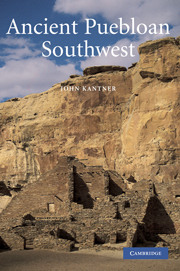Book contents
- Frontmatter
- Contents
- List of figures
- List of boxes
- Acknowledgments
- 1 The ancient Puebloan Southwest: an introduction
- 2 “The Daylight World”: the paleoenvironmental context for Puebloan history
- 3 Return to Ánosin Téhuli? The origins of Puebloan culture
- 4 The wrong Middle Places? Chaco Canyon and the Mimbres Mogollon
- 5 The migrations continue: the end of Chaco and Mimbres
- 6 The AD 1200s: the Great Pueblo period
- 7 The Great Abandonment
- 8 Finding Posi: the protohistoric Puebloan world
- References
- Index
1 - The ancient Puebloan Southwest: an introduction
Published online by Cambridge University Press: 05 February 2015
- Frontmatter
- Contents
- List of figures
- List of boxes
- Acknowledgments
- 1 The ancient Puebloan Southwest: an introduction
- 2 “The Daylight World”: the paleoenvironmental context for Puebloan history
- 3 Return to Ánosin Téhuli? The origins of Puebloan culture
- 4 The wrong Middle Places? Chaco Canyon and the Mimbres Mogollon
- 5 The migrations continue: the end of Chaco and Mimbres
- 6 The AD 1200s: the Great Pueblo period
- 7 The Great Abandonment
- 8 Finding Posi: the protohistoric Puebloan world
- References
- Index
Summary
In the late 1800s, as Anglo-American settlers moved into the Four Corners area of the United States where New Mexico, Arizona, Utah, and Colorado meet, they encountered a large number of ancient ruins, some of which were exceptionally imposing. Racist views about the indigenous inhabitants of the region, combined with a comparatively widespread knowledge of the Aztec empire encountered by the Spanish conquistadors, led many newcomers to assume that the local ruins with their impressive artifacts represented outposts of Mexican civilization. A substantial minority believed that they derived from the “lost tribes” of Israel or even more fanciful sources.
Although the evolution of the Four Corners region was influenced by developments in the great civilizations of Mesoamerica, and while many groups in the Southwest did interact with their neighbors to the south, the Aztecs did not build these structures. Archaeologists have instead determined that ancestors of current Native American groups living in this part of the United States built and lived in the villages now lying in ruins throughout the Four Corners. However, many of the questions raised by the nineteenth-century pioneers – Who were these people? Where did they come from? When did they live here? Why did they leave? – still structure the archaeology of this region, and they will be essential themes in this book.
One of the interesting problems in writing a general-interest book on archaeology is deciding how to bound your topic, both in time and in space.
- Type
- Chapter
- Information
- Ancient Puebloan Southwest , pp. 1 - 22Publisher: Cambridge University PressPrint publication year: 2004

